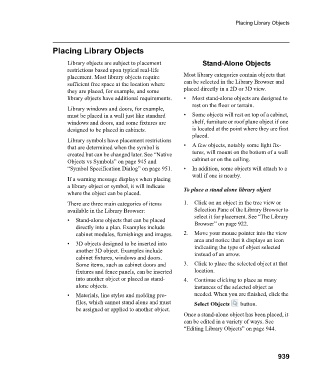Page 939 - Chief Architect Reference Manual
P. 939
Placing Library Objects
Placing Library Objects
Library objects are subject to placement Stand-Alone Objects
restrictions based upon typical real-life
placement. Most library objects require Most library categories contain objects that
sufficient free space at the location where can be selected in the Library Browser and
they are placed, for example, and some placed directly in a 2D or 3D view.
library objects have additional requirements. • Most stand-alone objects are designed to
rest on the floor or terrain.
Library windows and doors, for example,
must be placed in a wall just like standard • Some objects will rest on top of a cabinet,
windows and doors, and some fixtures are shelf, furniture or roof plane object if one
designed to be placed in cabinets. is located at the point where they are first
placed.
Library symbols have placement restrictions
that are determined when the symbol is • A few objects, notably some light fix-
created but can be changed later. See “Native tures, will mount on the bottom of a wall
Objects vs Symbols” on page 945 and cabinet or on the ceiling.
“Symbol Specification Dialog” on page 951. • In addition, some objects will attach to a
wall if one is nearby.
If a warning message displays when placing
a library object or symbol, it will indicate To place a stand alone library object
where the object can be placed.
There are three main categories of items 1. Click on an object in the tree view or
available in the Library Browser: Selection Pane of the Library Browser to
select it for placement. See “The Library
• Stand-alone objects that can be placed Browser” on page 922.
directly into a plan. Examples include
cabinet modules, furnishings and images. 2. Move your mouse pointer into the view
area and notice that it displays an icon
• 3D objects designed to be inserted into indicating the type of object selected
another 3D object. Examples include instead of an arrow.
cabinet fixtures, windows and doors.
Some items, such as cabinet doors and 3. Click to place the selected object at that
fixtures and fence panels, can be inserted location.
into another object or placed as stand- 4. Continue clicking to place as many
alone objects. instances of the selected object as
• Materials, line styles and molding pro- needed. When you are finished, click the
files, which cannot stand alone and must Select Objects button.
be assigned or applied to another object.
Once a stand-alone object has been placed, it
can be edited in a variety of ways. See
“Editing Library Objects” on page 944.
939

